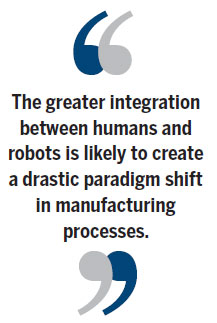
Humans and mechanical workers could soon toil side by side
Today, it's hard to imagine mass production, especially in automotive and other large-scale industries, without robotics. Yet when General Motors installed the very first robot, in 1961, it was as revolutionary as it was innovative, thanks to several key characteristics.
The first is that robots can move in an almost infinite number of positions, and they can be programmed, enabling them to make decisions and follow instructions. This level of automation intelligence was unheard of at the time and helped pave the way for modern robotic technology.
The massive use of robotics in the automotive sector drove much of the industry until several years ago. Since then, the industrial robotics market has expanded significantly, with 225,000 robots installed last year, according to the International Federation of Robotics.
This worldwide growth is the result of several factors. First, robotics is a synthesis of many technologies, including mechanics, electronics, mathematics and software. All of these disciplines, at various paces, have evolved naturally, and in doing so have brought sound innovation. The combined effects of such improvements have resulted in the better overall performance of robots.
Another market driver is the growing use of robotics in countries that until a few years ago were not "robot consumers". China is an excellent example, as it represents the largest consumer of robots in terms of new installations. Robotic sales in China grew between 2008 and 2014, and last year the country was the world's largest robot consumer, with 56,000 units.
In fact, the robot has become the state-of-the-art manufacturing tool in many industries and process, including automotive and electronics. In such industries, there is simply no question about how to produce certain components; robotics is the only option. This is true in Europe, the United States, China, and everywhere else in the world.

Another effect of the use of robots in production is that the quality of the process is systematically upgraded, since automated solutions require a consistent quality of the input components. In exchange, these solutions deliver the same quality standard for all finished products, with waste and rework reduced to a minimum.
Finally, the scope of how companies can use robotics is changing. Until now, there was a clear-cut separation between humans and robots in an industrial setting. For safety and security reasons, robots and operators were not able to share common workspaces and were divided by physical barriers.
In the late 1990s, a new branch of robotics known as "service robots" was developed to create systematic cooperation between operators and robots. These robots share many of the same technologies as industrial robots, but are used for different applications and in different sub-segments such as surgery, agriculture, elderly care aids, and in hazardous environments.
These two branches of robotics - industrial and service - are and will continue to be characterized by an inter-contamination of reciprocal technology, including the transfer of innovative solutions and improvements in performance and reliability.
Similarly, this convergence can be seen by a greater focus on the safety of the robot and robotic application. The present enabling technologies will increasingly facilitate human-robot cooperation, especially in small spaces and in applications such as handling and assembly. This opens the possibility for true autonomy in the robot's ability to cooperate with human operators in complete safety, without barriers.
The greater integration between humans and robots is likely to create a drastic paradigm shift in manufacturing processes in large, medium and small industry. It is, in fact, one of the key issues driving development. Just imagine a situation in which the operator and the robot work side by side, executing their tasks to the best of their abilities. The automation would likely be used for heavy, boring, repetitive and dangerous tasks, as well as tasks that necessitate extreme speed, while the human operator would focus on tasks that require intelligence, care and dexterity.
Experts from various professional backgrounds are now trying to predict the future industrial and socio-economic scenarios linked to this phenomenon. They are also considering the possible impact on the creation of new occupations, and other parameters that may arise from the deployment of new technologies related to advanced robotics.
In any case, the powerful and unstoppable dynamics of the technological developments taking place in the various segments of robotics will result in radical changes in multiple sectors. The limits of which, today, are difficult to define.
The author is president of International Federation of Robotics.
(China Daily Africa Weekly 06/19/2015 page9)








